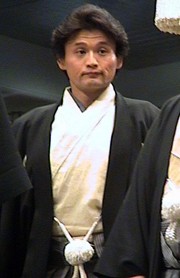| Yokozuna Comparisons Joe Kuroda |

 |
| Amateur Sumo's Global Aspirations Courtesy: International Sumo Federation |

 |
| Rikishi of Old Joe Kuroda |

 |
| Heya Peek Barbara Ann Klein |

 |
| SFM Interview Mark Buckton |

 |
| Sumo 101 Barbara Ann Klein |

 |
| Photo Bonanza See the Haru |
 |
| Haru Basho Review Lon Howard |

 |
| Lower Division Rikishi Mikko Mattila |

 |
| Natsu Basho Forecast Mark Buckton |

 |
| Kimarite Focus Mikko Mattila |

 |
| Sumo in Print Mark Buckton |

 |
| Kokugi Connections Todd Lambert |

 |
| Fan Debate Facilitator – Lon Howard |

 |
| SFM Cartoons Benny Loh & Stephen Thompson |

 |
| Let’s Hear From You What was it that |

 |
| Readers’ Letters See what some |

 |
Sumo Quiz
The Quizmaster
Answer the Qs and win yourself next basho’s banzuke.
Yokozuna Takanohana stellte sehr schnell eine Anzahl Rekorde der Kategorie “jüngster” auf während seines Aufstiegs durch die Ränge:
 Makushita Yusho – 16 Jahre, 9 Monate
Makushita Yusho – 16 Jahre, 9 Monate Juryo Promotion – 17 Jahre, 2 Monate
Juryo Promotion – 17 Jahre, 2 Monate Makuuchi Promotion – 17 Jahre, 8 Monate
Makuuchi Promotion – 17 Jahre, 8 Monate Sansho award – 18 Jahre, 7 Monate
Sansho award – 18 Jahre, 7 Monate Erster Kinboshi – 18 Jahre, 9 Monate
Erster Kinboshi – 18 Jahre, 9 Monate Komusubi Beförderung – 18 Jahre, 11 Monate
Komusubi Beförderung – 18 Jahre, 11 Monate Sekiwake Beförderung – 19 Jahre, 1 Monate
Sekiwake Beförderung – 19 Jahre, 1 Monate Erstes Makuuchi Yusho – 19 Jahre, 5 Monate (Asashoryu gewann sein erstes mit 22 Jahre 1 Monate)
Erstes Makuuchi Yusho – 19 Jahre, 5 Monate (Asashoryu gewann sein erstes mit 22 Jahre 1 Monate) Ozeki Beförderung – 20 Jahre, 5 Monate
Ozeki Beförderung – 20 Jahre, 5 Monate
Takanohana (Photo von Barbara Ann Klein)
Zwischen März 1993 und November 1997 gewann Takanohana 21-mal das Yusho oder hatte ein vergleichbar gutes Ergebnis und war 5-mal zweiter. Während dieser Zeit
Im Januar 2003 trat Takanohana zurück und bekam ein Eine-Generation-Toshiyori, was vorher nur drei Yokozuna erhielten, Taiho, Kitanoumi und Chiyonofuji waren ebenfalls für herausragende Leistungen als Yokozuna vom NSK damit ausgezeichnet worden. Yokozuna Taiho ist inzwischen aus dem NSK ausgeschieden und jetzt Direktor des Sumo Museums. Takanohana und Kitanoumi sind jetzt die einzigen aktiven Eine-
Generation-Toshiyori-Halter, da der früher Yokozuna Chiyonofuji verzichtete. Er plante stattdessen den Titel Kokonoe Oyakata anzunehmen.
Am 1. Juni 2004 übernahm Takanohana offiziell das Futagoyama-Beya von seinem Vater und benannte es in Takanohana-Beya um. Sein Vater und Shisho, Futagoyama Oyakata, der frühere Ozeki Takanohana arbeitete unermüdlich weiter als Direktor des Sumoverbandes bis zu seinem Tod durch Krebs im Mund am 30. Mai 2005. Auch wenn Takanohana versprach das Vermächtnis seines Vaters weiterzuführen so hat er doch keine Verantwortung im
Weiter
